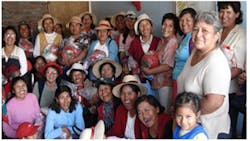California Company Is a Model for Responsible Fashion Supply Chain Ethics
“No one should suffer or die to make clothing. Just the opposite, they and their families should prosper. That's how it is with our supply chain,” asserts Scott Leonard, co-founder and CEO of California-based clothing manufacturer INDIGENOUS. “That's how it can be with others. Let's not make this harder than it is. And let's not wait. Lives are at stake.”
For almost two decades, INDIGENOUS has led the way in fair trade and organic fashion. Over 1,500 artisan knitters in some of South America’s poorest regions participate in the INDIGENOUS supply chain.
"Accidents like the one that happened in Bangladesh simply would not happen in our supply chain,” said Leonard. “We independently survey workers every 6 months, require participatory and fair labor practices, personally tour workshops and pay prices that make safety, benefits and fair wages easy to achieve.”
Co-founder and President Matt Reynolds claims the INDIGENOUS model is readily replicable, adding that despite potentially losing “a distinctive competitive advantage,” the company is ready to share it “to help save lives and promote the well-being of artisans and garment workers everywhere.”
INDIGENOUS independently collected data that shows that 75 percent of artisans in its supply chain are no longer at risk of poverty. Many are achieving milestones of financial security, even growth as some start their own artisan workshops. Workplaces are safe and provide benefits. A full 85 percent of workers say they are better off since participating in this supply chain.
The 3 Key Elements
The model created by INDIGENOUS has three key elements:
- The first is continuous supply chain monitoring and the promotion of artisan rights and engagement in all aspects of workplace policy and practice. INDIGENOUS uses innovative SMS and voice technology to directly survey workers about their economic, social and workplace well-being. This allows their opinions to be shared privately and confidentially.
- The second is transparency. From the provenance of its organically grown fibers to the status of artisans and artisan communities, INDIGENOUS shares information about its supply chain in a way that goes beyond simple, iconic labeling. Video profiles of artisans, artisan workshops, and supply chain source maps are just a few of the tools.
- The third is consumer engagement in the value of fair trade and organic fashion. This fall, every INDIGENOUS garment will come with a QR code on the hang tag. The QR code launches INDIGENOUS proprietary Fair Trace Tool, an application that lets the consumer meet the artisans who made the garment, understand the social impact of purchasing the garment and other facts, delivered in text, video and animated map format.
INDIGENOUS is prepared to share its best practices and innovative supply chain transparency tools with any fashion brand that is willing to stand up and take the pledge that “no one will suffer or die to make our clothes. Instead, they will prosper.” They will also immediately adopt new standards of transparency. “This is a call to action for you to stand up and be heard,” said Leonard.
About the Author

Sandy Smith
Sandy Smith is the former content director of EHS Today, and is currently the EHSQ content & community lead at Intelex Technologies Inc. She has written about occupational safety and health and environmental issues since 1990.
